child restraint CADILLAC SEVILLE 1999 5.G Owners Manual
[x] Cancel search | Manufacturer: CADILLAC, Model Year: 1999, Model line: SEVILLE, Model: CADILLAC SEVILLE 1999 5.GPages: 362, PDF Size: 2.65 MB
Page 7 of 362
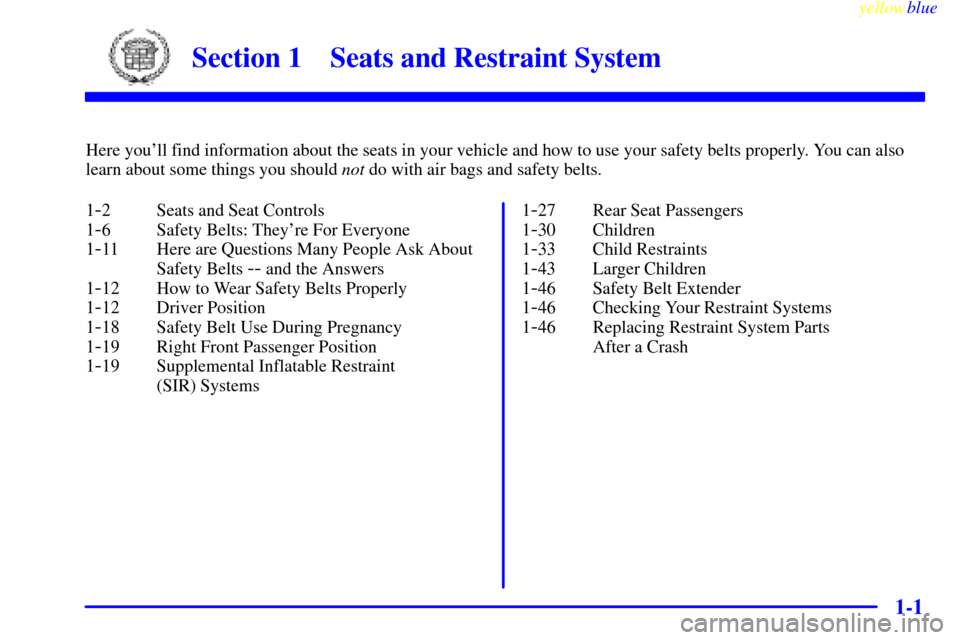
1-
yellowblue
1-1
Section 1 Seats and Restraint System
Here you'll find information about the seats in your vehicle and how to use your safety belts properly. You can also
learn about some things you should not do with air bags and safety belts.
1
-2 Seats and Seat Controls
1
-6 Safety Belts: They're For Everyone
1
-11 Here are Questions Many People Ask About
Safety Belts
-- and the Answers
1
-12 How to Wear Safety Belts Properly
1
-12 Driver Position
1
-18 Safety Belt Use During Pregnancy
1
-19 Right Front Passenger Position
1
-19 Supplemental Inflatable Restraint
(SIR) Systems1
-27 Rear Seat Passengers
1
-30 Children
1
-33 Child Restraints
1
-43 Larger Children
1
-46 Safety Belt Extender
1
-46 Checking Your Restraint Systems
1
-46 Replacing Restraint System Parts
After a Crash
Page 18 of 362

yellowblue
1-12
How to Wear Safety Belts Properly
Adults
This part is only for people of adult size.
Be aware that there are special things to know about
safety belts and children. And there are different rules
for smaller children and babies. If a child will be riding
in your vehicle, see the part of this manual
called ªChildren.º Follow those rules for
everyone's protection.
First, you'll want to know which restraint systems your
vehicle has.
We'll start with the driver position.
Driver Position
This part describes the driver's restraint system.
Lap-Shoulder Belt
The driver has a lap-shoulder belt. Here's how to wear
it properly.
1. Close and lock the door.
2. Adjust the seat (to see how, see ªSeatsº in the Index)
so you can sit up straight.
3. Pick up the latch plate and pull the belt across you.
Don't let it get twisted.
The lap
-shoulder belt may lock if you pull the belt
across you very quickly. If this happens, let the belt
go back slightly to unlock it. Then pull the belt
across you more slowly.
Page 25 of 362

yellowblue
1-19
The best way to protect the fetus is to protect the
mother. When a safety belt is worn properly, it's more
likely that the fetus won't be hurt in a crash. For
pregnant women, as for anyone, the key to making
safety belts effective is wearing them properly.
Right Front Passenger Position
To learn how to wear the right front passenger's safety belt
properly, see ªDriver Positionº earlier in this section.
The right front passenger's safety belt works the same
way as the driver's safety belt
-- except for one thing. If
you ever pull the lap portion of the belt out all the way,
you will engage the child restraint locking feature. If
this happens, just let the belt go back all the way and
start again.
Supplemental Inflatable Restraint
(SIR) Systems
This part explains the frontal and side impact
Supplemental Inflatable Restraint (SIR) systems or air
bag systems.
Your vehicle has four air bags
-- a ªNext Generationº
frontal air bag for the driver, another ªNext Generationº
frontal air bag for the right front passenger, a side
impact air bag for the driver, and another side impact air
bag for the right front passenger.Next Generation frontal air bags are designed to help
reduce the risk of injury from the force of an inflating
frontal air bag. But even these air bags must inflate very
quickly if they are to do their job and comply with
federal regulations.
Here are the most important things to know about the air
bag systems:
CAUTION:
You can be severely injured or killed in a crash if
you aren't wearing your safety belt
-- even if you
have air bags. Wearing your safety belt during a
crash helps reduce your chance of hitting things
inside the vehicle or being ejected from it. Air
bags are ªsupplemental restraintsº to the safety
belts. All air bags
-- even Next Generation air
bags
-- are designed to work with safety belts but
don't replace them.
CAUTION: (Continued)
Page 27 of 362
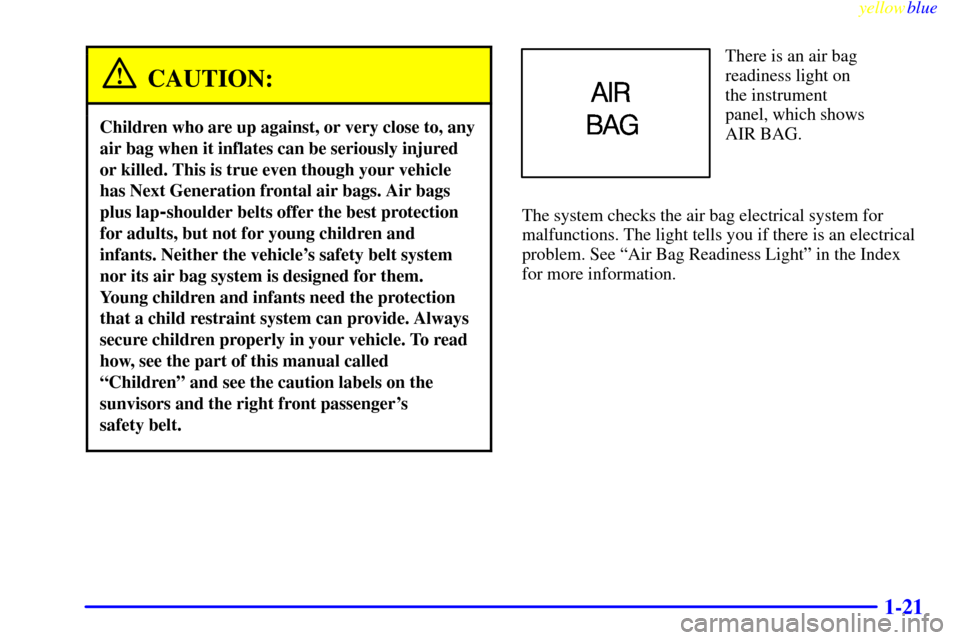
yellowblue
1-21
CAUTION:
Children who are up against, or very close to, any
air bag when it inflates can be seriously injured
or killed. This is true even though your vehicle
has Next Generation frontal air bags. Air bags
plus lap
-shoulder belts offer the best protection
for adults, but not for young children and
infants. Neither the vehicle's safety belt system
nor its air bag system is designed for them.
Young children and infants need the protection
that a child restraint system can provide. Always
secure children properly in your vehicle. To read
how, see the part of this manual called
ªChildrenº and see the caution labels on the
sunvisors and the right front passenger's
safety belt.
There is an air bag
readiness light on
the instrument
panel, which shows
AIR BAG.
The system checks the air bag electrical system for
malfunctions. The light tells you if there is an electrical
problem. See ªAir Bag Readiness Lightº in the Index
for more information.
Page 36 of 362
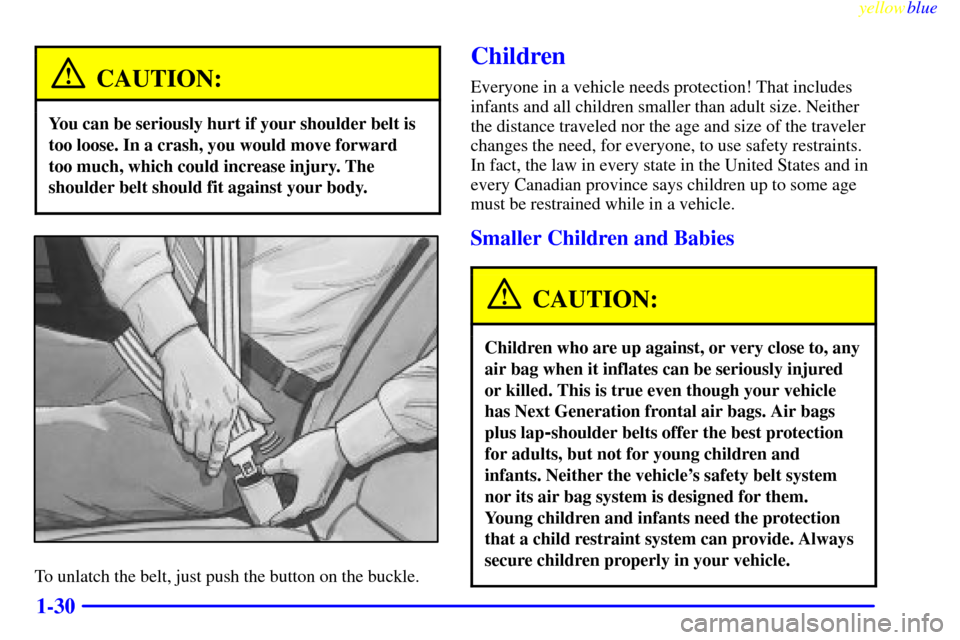
yellowblue
1-30
CAUTION:
You can be seriously hurt if your shoulder belt is
too loose. In a crash, you would move forward
too much, which could increase injury. The
shoulder belt should fit against your body.
To unlatch the belt, just push the button on the buckle.
Children
Everyone in a vehicle needs protection! That includes
infants and all children smaller than adult size. Neither
the distance traveled nor the age and size of the traveler
changes the need, for everyone, to use safety restraints.
In fact, the law in every state in the United States and in
every Canadian province says children up to some age
must be restrained while in a vehicle.
Smaller Children and Babies
CAUTION:
Children who are up against, or very close to, any
air bag when it inflates can be seriously injured
or killed. This is true even though your vehicle
has Next Generation frontal air bags. Air bags
plus lap
-shoulder belts offer the best protection
for adults, but not for young children and
infants. Neither the vehicle's safety belt system
nor its air bag system is designed for them.
Young children and infants need the protection
that a child restraint system can provide. Always
secure children properly in your vehicle.
Page 37 of 362
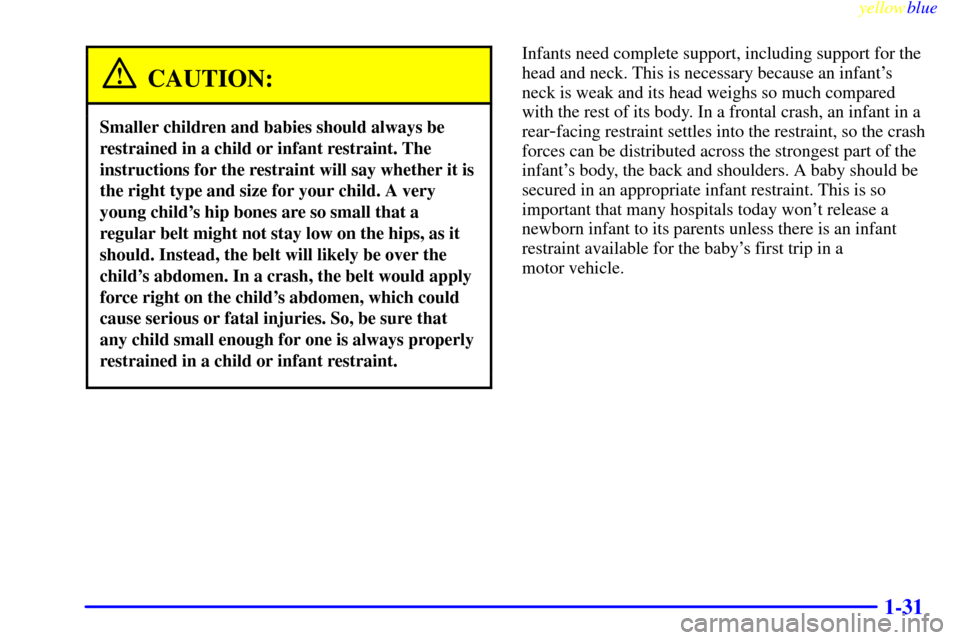
yellowblue
1-31
CAUTION:
Smaller children and babies should always be
restrained in a child or infant restraint. The
instructions for the restraint will say whether it is
the right type and size for your child. A very
young child's hip bones are so small that a
regular belt might not stay low on the hips, as it
should. Instead, the belt will likely be over the
child's abdomen. In a crash, the belt would apply
force right on the child's abdomen, which could
cause serious or fatal injuries. So, be sure that
any child small enough for one is always properly
restrained in a child or infant restraint.
Infants need complete support, including support for the
head and neck. This is necessary because an infant's
neck is weak and its head weighs so much compared
with the rest of its body. In a frontal crash, an infant in a
rear
-facing restraint settles into the restraint, so the crash
forces can be distributed across the strongest part of the
infant's body, the back and shoulders. A baby should be
secured in an appropriate infant restraint. This is so
important that many hospitals today won't release a
newborn infant to its parents unless there is an infant
restraint available for the baby's first trip in a
motor vehicle.
Page 39 of 362

yellowblue
1-33
Child Restraints
Every time infants and young children ride in
vehicles, they should have protection provided by
appropriate restraints.
Q:What are the different types of add-on
child restraints?
A:Add-on child restraints are available in four basic
types. When selecting a child restraint, take into
consideration not only the child's weight and size,
but also whether or not the restraint will be
compatible with the motor vehicle in which it will
be used.
An infant car bed (A) is a special bed made for use
in a motor vehicle. It's an infant restraint system
designed to restrain or position a child on a
continuous flat surface. With an infant car bed,
make sure that the infant's head rests toward the
center of the vehicle.
Page 41 of 362

yellowblue
1-35
A forward-facing child restraint (C-E) positions a
child upright to face forward in the vehicle. These
forward
-facing restraints are designed to help
protect children who are from 20 to 40 lbs.
(9 to 18 kg) and about 26 to 40 inches
(66 to 102 cm) in height, or up to around four years
of age. One type, a convertible restraint, is
designed to be used either as a rear
-facing infant
seat or a forward
-facing child seat.
Page 43 of 362
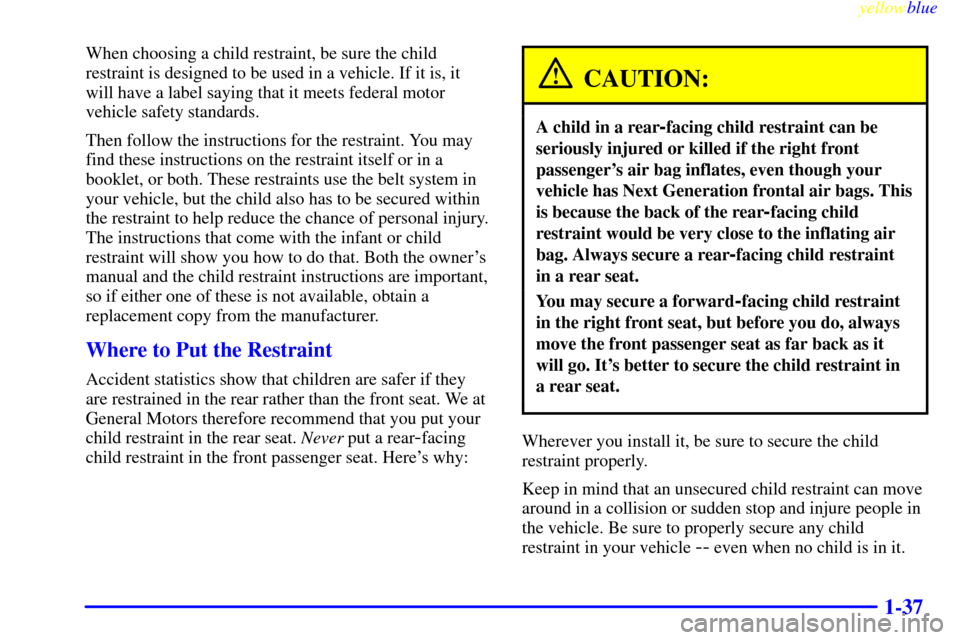
yellowblue
1-37
When choosing a child restraint, be sure the child
restraint is designed to be used in a vehicle. If it is, it
will have a label saying that it meets federal motor
vehicle safety standards.
Then follow the instructions for the restraint. You may
find these instructions on the restraint itself or in a
booklet, or both. These restraints use the belt system in
your vehicle, but the child also has to be secured within
the restraint to help reduce the chance of personal injury.
The instructions that come with the infant or child
restraint will show you how to do that. Both the owner's
manual and the child restraint instructions are important,
so if either one of these is not available, obtain a
replacement copy from the manufacturer.
Where to Put the Restraint
Accident statistics show that children are safer if they
are restrained in the rear rather than the front seat. We at
General Motors therefore recommend that you put your
child restraint in the rear seat. Never put a rear
-facing
child restraint in the front passenger seat. Here's why:
CAUTION:
A child in a rear-facing child restraint can be
seriously injured or killed if the right front
passenger's air bag inflates, even though your
vehicle has Next Generation frontal air bags. This
is because the back of the rear
-facing child
restraint would be very close to the inflating air
bag. Always secure a rear
-facing child restraint
in a rear seat.
You may secure a forward-facing child restraint
in the right front seat, but before you do, always
move the front passenger seat as far back as it
will go. It's better to secure the child restraint in
a rear seat.
Wherever you install it, be sure to secure the child
restraint properly.
Keep in mind that an unsecured child restraint can move
around in a collision or sudden stop and injure people in
the vehicle. Be sure to properly secure any child
restraint in your vehicle
-- even when no child is in it.
Page 44 of 362
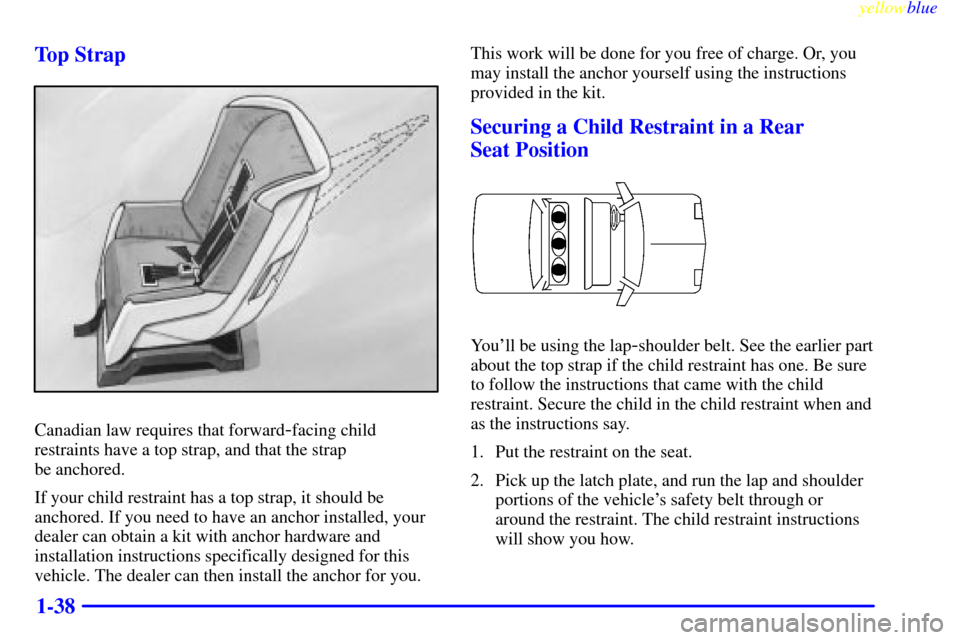
yellowblue
1-38 Top Strap
Canadian law requires that forward-facing child
restraints have a top strap, and that the strap
be anchored.
If your child restraint has a top strap, it should be
anchored. If you need to have an anchor installed, your
dealer can obtain a kit with anchor hardware and
installation instructions specifically designed for this
vehicle. The dealer can then install the anchor for you.This work will be done for you free of charge. Or, you
may install the anchor yourself using the instructions
provided in the kit.
Securing a Child Restraint in a Rear
Seat Position
You'll be using the lap-shoulder belt. See the earlier part
about the top strap if the child restraint has one. Be sure
to follow the instructions that came with the child
restraint. Secure the child in the child restraint when and
as the instructions say.
1. Put the restraint on the seat.
2. Pick up the latch plate, and run the lap and shoulder
portions of the vehicle's safety belt through or
around the restraint. The child restraint instructions
will show you how.